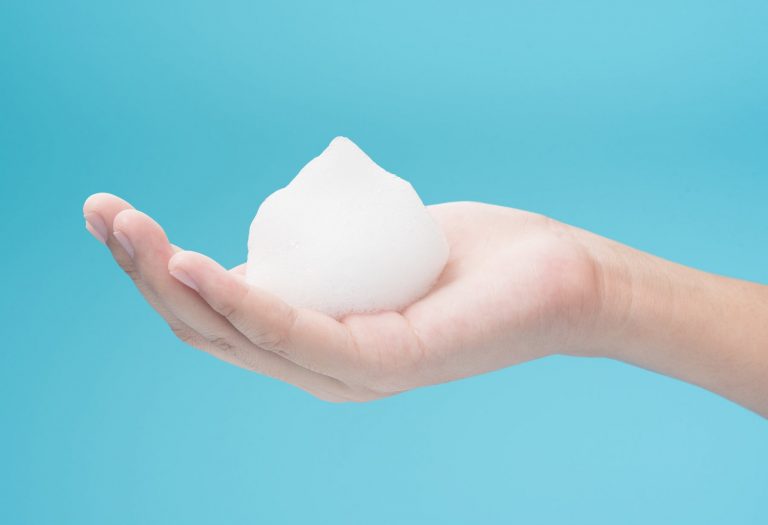Washing your face should be simple, but we’re sorry to say that it’s not — especially for those who wear makeup. With foundation on your skin, mascara on your lashes, and a long-wear lipstick coating your lips, cleansing becomes more important than ever, and while you may think a simple makeup wipe or wash with soap will do the trick, it won’t. There are both right and wrong ways to remove makeup, and we’re going to break down what you need to do to avoid breaking out.
Once you understand the right and wrong ways to remove makeup, your morning and night routines will become so much more doable. We promise.
Right: Cleansing with oil
One of the most universally approved ways to remove makeup is with an oil cleanser. If you’re unfamiliar with this type of cleanser, the principle behind it relies on the idea that the good oils in the cleanser remove the bad oils (like makeup and sebum) from your face. According to Huffington Post, the cleansing oils bind with those other oils to remove every impurity and bit of makeup when rinsed away. It also means that if you have oily skin and the idea of an oil cleanser makes you want to run away screaming, you shouldn’t be worried. All those oils will be washed away, which means they won’t clog pores and lead to breakouts.
Oil cleansing is my personal go-to for removing makeup, and perhaps my favorite thing about the process is how simple it is. I’ve used balms that when warmed in your hands transform into an oil, as well as a straight oil cleanser with a pump. Both work wonders and, by wonders, it’s truly a wonder. While typical gel or foaming cleansers don’t always remove things like mascara, an oil cleanser gets it all. For most formulations, simply massage the oil over dry skin and then use a bit of water to emulsify the product on your face, before finally rinsing with warm water. Boom! No more makeup for you.
Try Burt’s Bees Facial Cleansing Oil, $13.89.
MORE: The no-shame guide to Botox & other cosmetic facial treatments
Wrong: Using makeup wipes only
Look, we’ve all been there. A night rolls around where you’ve been out with your friends and just can’t be bothered to go through an entire cleansing routine, so you turn to your trusty makeup wipes. Don’t. While it may look like your makeup is gone, it’s all superficial. Don’t do this to yourself. No, we aren’t making this up just to complicate your life. According to Glamour’s interview with dermatologist Dr. Joshua Zeichner, makeup wipes can lead to irritation, thanks to the fact they’re basically smearing around dirt, oil and whatever makeup is left behind. Add to that ingredients that lead to inflammation, and it’s just not the way to go.
Don’t rush to throw away your wipes just yet, though. While there is relative consensus that they aren’t the best way to cleanse the skin, they can be okay for an initial cleanse. Huffington Post reports that when followed by an actual cleanser, makeup wipes actually aren’t the devil.
Right: Being gentle while removing makeup
The urge to pluck the fibers off you eyelashes may be great, and an overwhelming desire to scrub at your face until it’s shiny and red to ensure your makeup is gone may seem OK, but neither of these things is good for your skin health. Instead, gentle cleansing is key. Tugging at your eyes to remove mascara or scrubbing your face with an exfoliator can cause everything from premature wrinkles to microtears in the skin. Instead, opt for gentle but effective options.
There are a few ways to make sure your cleanser is gentle. First, don’t turn the water temperature up too high to avoid stripping your skin. Next, make sure you’re not scrubbing your face or lathering for too long. A 20–30-second gentle motion should be sufficient, according to Self.
Wrong: Not double cleansing
Surprise! There’s a second step to that oil cleansing method, and it’s incredibly important. Think about it this way. You’ve used an oil-based cleanser to remove your makeup. That’s great, but what about actually treating and cleansing your skin? A foaming or water-based cleanser can now directly interact with your skin without a barrier (i.e. your makeup).
One you’ve removed all of the impurities from your skin, you can now go in with a cleanser that contains ingredients to target your skin concerns. If you want to exfoliate, try an option with alpha hydroxy acids. If you need something to hydrate, CeraVe is a cult classic.
Right: Using a cleanser for your skin type
Not all cleansers are created equal when it comes to your skin. Someone who has dry skin won’t want a product that’s oil-free, while a person who is acne-prone will want a cleanser with exfoliating AHAs. After you’ve removed your makeup with an oil cleanser, your second cleanser will help treat whatever issues you may be experiencing. This means you’ll need to assess your skin and figure out your skin type (if you don’t already know) in order to get the best possible makeup remover and cleansing experience.
MORE: 7 Pantry items you can use in your skin care routine
Wrong: Not taking your makeup off at all
This may seem obvious, but let’s be honest with ourselves. We’ve all done this. We also probably know people who do this regularly. While an occasional night out where you forget to wash your face may be something to easily fix, not removing all of your makeup before bed can have serious consequences for your skin.
Your skin repairs itself at night, and makeup can prevent that process from fully taking place. Plus, leftover makeup can do the most obvious thing: clog pores and cause breakouts. If you haven’t been removing your makeup every night, it’s time to start.
While removing your makeup may not be as simple as you previously believed, an extra bit of cleansing never hurt anyone, and we promise, your skin will thank you.









